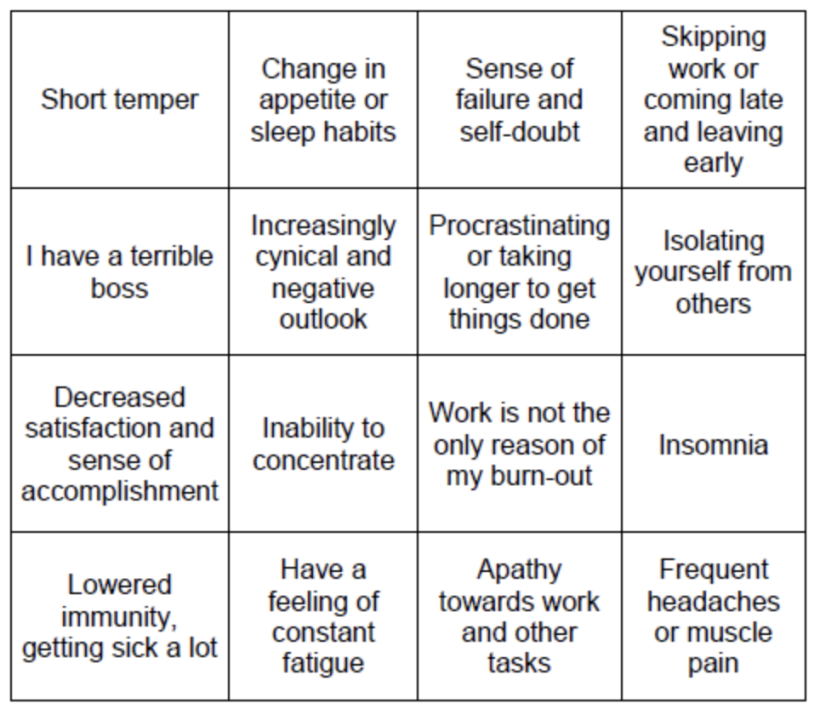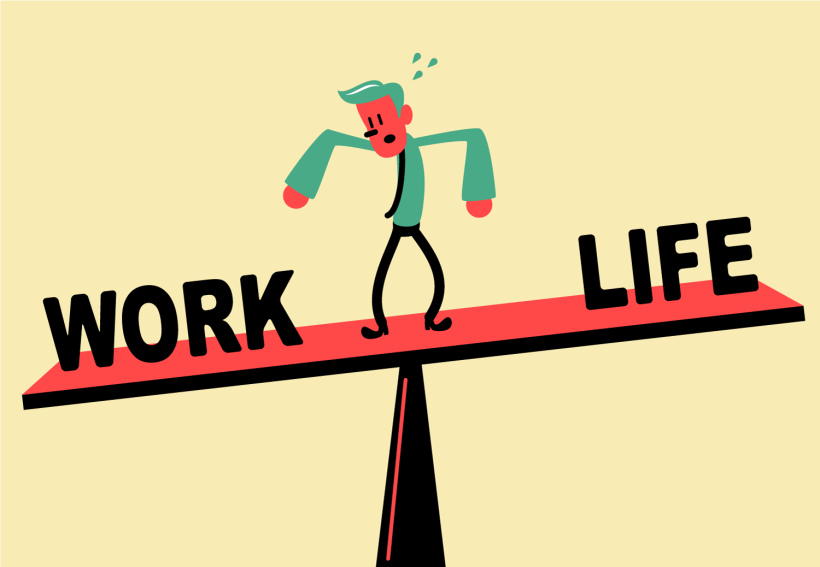At Co-Searching, we know burnout all too well: among our employees and volunteers, several people have struggled with it, or are still recovering from this 21st century plague. We are lucky to be able to heal from our negative experiences by turning them into positive learnings throughout our daily activities, but you know what would be even better? Making sure people don’t get to that point anymore and recognise the early signs that their balance isn’t working.
We recently held a workshop on burnout prevention, and our blogger Padma decided to bundle some of our insights in a blogpost.

Do you identify with one or more of the statements above and don’t know what it is? Well, if you are a working professional, you’ve probably heard about the term ‘burnout’, especially post COVID-19. If you Google ‘burnout at work’ you get 0.56 million results; many people are struggling, so if it’s any consolation, you are not alone!
In our latest workshop, we did a deep dive into this hot topic and discussed ways to identify and tackle burnout. We went in search of how burnout affects the physical and mental health of the individual and ultimately their work performance. How should they cope with burnout and how to overcome it?
What is burnout?
Today, a lot of us experience intense pressure to do well at work. Most businesses today focus on hypergrowth, which raises the bar for what is expected of staff. Additionally, with a population that is becoming more educated and tech-savvy, we can occasionally feel like we are readily replaceable if we don’t live up to those expectations at work. People may feel as though they have reached a brick wall as a result of the strain, stress, and occasionally associated anxiety.
Burnout is not the same as stress at work. Stress occurs when a person tries to adapt to their workload. This is not necessarily negative. On the other side, burnout happens when adaptation alone is not enough, and the state of stress persists for a long time. Depression and burnout partially overlap, and burnout may be an eliciting factor in the development of depression.
According to a recent study by HR company Securex, in collaboration with KU Leuven University, the risk of burnout among employees has risen sharply in recent Covid-19 years in Belgium. 28.5% of Belgian employees were at risk of burnout in the fall of 2021 as compared to 23.8% in 2018 and 2019.
Not an occupational disease
Burnout has become such a widespread problem that there’s even an official diagnosis for it. In May 2019, the World Health Organization (WHO) recognized burnout as an occupational disease by including the condition in its International Classification of Diseases (ICD-11), a globally recognized benchmark for health diagnoses.
Barely one day later, WHO released a clarification describing burnout as an occupational phenomenon — one of the factors influencing health status and contact with health services — but not a medical condition. According to WHO, burnout is characterized by “feelings of energy depletion or exhaustion; increased mental distance from one’s job, or feelings of negativism or cynicism related to one’s job; and reduced professional efficacy.”
Causes of Burnout
Burnout can result from a variety of factors. Internal factors like perfectionism, insufficient sleep, lack of exercise or a bad diet for example, but also vulnerability to stress, difficulties to say ‘no’ and mental health predispositions. Of course, external factors come into play as well: toxic workplace dynamics where (perceived) injustice, bullying, discrimination are present, a lack of recognition, of opportunities…

How to identify the signs and symptoms of burnout?
Knowing that job burnout has a variety of affects and manifests itself differently for various people is crucial. Additionally, because work pressure affects different people in different ways, the causes may not always be the same as the symptoms. There are various ways that burnout can present itself — some more obvious than others. We identified some key symptoms that can help you identify burnout.
You may be experiencing burnout if you:
- are feeling tired all the time
- have high cortisol levels (the “stress hormone”)
- are becoming cynical, not feeling positive anymore
- have low self-esteem
- are not much productive anymore
- have concentration or memory problems
- have other physical symptoms like headaches, backaches, muscle aches and sleep disturbances
- are facing increased irritability
- have a tendency to be less social
How to prevent burnout?
In contrast to stress, burnout is all about a void: a sense of emptiness, apathy, exhaustion, being used up, and a loss of desire. Burnout is overwhelming and seems unavoidable, much like despair. You feel like there is no way out once you understand you are trapped. So frequently, attempts to get back on track are simply abandoned, possibly with terrible outcomes. Burnout, however, is both preventable and manageable.
During the workshop, we identified various steps you can take to prevent burnout:
- Inform yourself: You can find a lot of TEDx talks of experts talking about burnout. Some of the TEDx talks you can begin with are:Talks for when you feel totally burned out,The cure for burnout, andHow to Bounce Back from Burnout in 3 Simple Steps. Look into scientific research atresearchgate, read books — find something that speaks to you. Meet other people who experience similar hardship, through social or self-help groups. Co-Searching organises conversation groups from time to time, subscribe to our newsletterto stay in the loop.
- Bring balance to your life:It’s time to put your attention on something you care about, rather than dwelling too much on your job if it’s controlling your life and negatively affecting other elements of it. Find a cause you believe in, or get involved with a group of people that share your values and are admirable or inspiring. Plan time with friends or do other social activities. Discovering value outside of your work is the objective here.
- Make some changes when it comes to working: It’s crucial to be able to establish limits in both your personal and professional lives. Take time out and go meet your friends and family when you want to, say ‘no’ to a meeting if it is outside your working hours. It becomes much simpler to decline initiatives when you are able to manage the expectations of those around you.
- Improve your communication: You must have clear and open communication with your co-workers and supervisors in order to prevent burnout at work, and not just in the short term. It won’t help you to suffer in silence, therefore it’s critical that you can express how you feel when you’re overburdened and underworked. It may be easier to find solutions to a mountainous workload by focusing on internal communication, such as co-workers who can step up and lessen your burden, or by promoting an open dialogue where others can also express their worry around workload expectations. Keep in mind thatif you never mention your feelings of burnout, no one will likely notice until your job begins to suffer, and by then, it will be too late.
- Take a break: When you feel like you need one, take one. When we try to be productive, we frequently just sit and try to maintain our attention for extended periods of time. But doing so can have the opposite effect. And it’s crucial that you simply take time out to recover if you do get burnout. To make sure that the same stressors aren’t just waiting for you when you get back, you still need to have those dialogues at work.
Professional guidance
Burnout has been referred to as the health crisis of the century and is frequently referred to as overachiever syndrome. Although Belgium has historically lagged in addressing mental health concerns in the workplace, it is finally realizing the costs to both individuals and companies. If you are residing in Belgium, you can get in touch with the following agencies:
- GTB is THE government organisation helping people with a mental or physical disability (re)integrate the job market.
- Herstelacademie offers courses helping people with a mental vulnerability to take their recovery process in their own hands.
- Fedris project, to resume work or keep working in the financial sector, government, healthcare.
- Your own health insurance organization that offers reintegration trajectories.
- VDAB in Flanders offers reintegration coaches who work together with health insurances.
- the human link offers group and individual therapy specifically addressing stress and burnout.
- Many companies have their own prevention advisor to offer help to their employees. Reach out to your HR team.
- TheNamaste house in Ghent (supported by the government).
- Your doctor can refer you to a mental health center (CGG) if you need therapy. A lot of times it is cheaper when you get a referral from your doctor.
- CAW helps people with all their questions and problems related to well-being and provides a broad offer of trajectories, advisors, information, and crisis help.
Would you like to be the first to know about the next Co-Searching workshops? Then be sure to subscribe to our newsletter!
